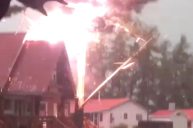I know what you are thinking. What in the Avatar: The Last Airbender is going on here? I get it, this is news to me as well. A tree that can wield lightning is not something that I had on my 2025 bingo card. So, how in the world does this tropical tree harness the electrical power of the bolts and use it to its benefit?
Learn How This Tropical Tree Can Wield Lightning

Shutterstock Image
Introducing the tonka bean tree. The NY Post shares its scientific name, Dipteryx oleifera. While most people, and creatures, have come to fear lightning for its deadly consequences and the destruction it leaves behind, the tonka bean tree has learned how to work with it. Not only has this tropical tree learned how to survive the lightning attacks, but it has learned how to transfer the electricity.
Why would it want to do that? To help eliminate its 'enemies.' Now I know your next question. What on earth is the enemy of a tree? Well, like many other plants and trees, anything that is competing for resources is considered an enemy or opponent. In this tree's case, it would be parasitic vines that cling to the tonka bean tree. Although lightning seems to be a leading cause of destruction for most trees, researchers noticed that was not the case with this tropical tree.
In an interview with Live Science, Evan Gora, forest ecologist at the Cary Institute of Ecosystem Studies, spoke about these trees. Gora said, "We started doing this work 10 years ago, and it became really apparent that lightning kills a lot of trees, especially a lot of very big trees. But Dipteryx oleifera consistently showed no damage."
Researchers Dive Deeper
Through the use of cameras and a "custom-built system with electric field sensors" researchers were able to study this phenomenon. The NY Post shared that "They were able to triangulate the strikes with high accuracy by studying the energy patterns recorded." After reviewing all of their data, the found that the "tonka bean tree stood out" because it was the one species that "consistently showed little to no damage after a lightning strike."
However, while the fact that this tree can wield lightning is beneficial for it, it is not beneficial for anything around it. Gora mentioned that "there's a quantifiable, detectable hazard of living next to Dipteryx oleifera." Basically, if you are living next to a tonka bean tree, you have a higher chance of dying from a lightning strike. Scientists came to this conclusion after assessing the data they collected. According to the data, "each strike of lightning killed more than 2.4 tons on average of nearby tree biomass and 78% of the parasitic vines that attached to the tonka bean tree's canopy."
Furthermore, the massive height of the tonka tree makes it an easy target for lighting. Growing up to 130 feet tall, researchers believe that each tonka tree gets struck an average of five times during their mature life time. Each time that happens, they use the lightning to help take out their 'enemies', aka. nearby vines and competitors. So after learning all of this you need to ask yourself, would you live anywhere near a tree that can wield lightning?




